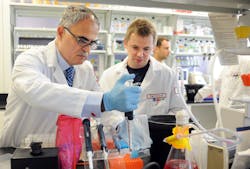Guardair Solves the PCS Challenge
BK: What led Guardair to develop this particular pneumatic vacuum, called the “Pesonnel Cleaning Station” (PCS)?
MY: It is quite common in many industries to see people cleaning themselves off by using compressed air to blow off chips, dirt, etc. But this is a dangerous activity. Per OSHA Directive STD 01-13-001, users are prohibited from using compressed air with a “gun, pipe, or cleaning lance” for self-cleaning which might blow “a chip or particle into the eyes or unbroken skin of the operator or other workers.” One alternative to blowing yourself off is to use a vacuum. However, it is much quicker to blow yourself off than to vacuum yourself off, which is why you still see it happening. Guardair saw an opportunity to develop an efficient, yet safe alternative.
BK: How is this pneumatic vacuum different from similar ones currently being offered?
MY: The Personnel Cleaning Station (PCS) is designed specifically for personnel cleaning. It allows the user to blow themselves off safely. The PCS runs off of standard shop compressed air and its brush attachment pairs an on-demand air-agitator nozzle with a high-efficiency pneumatic vacuum. Thumb-switch activated, the air-agitator loosens and lifts particles airborne where the vacuum sucks them away safely and effectively.
BK: Any particular problems come up during the development process?
MY: One major challenge with developing the brush attachment was determining how to allow end users to blow themselves off, but ensuring that it was done in a safe manner. First, we had to size the system so that when the agitator was turned on, it did not simply blow particles out from under the brush. That required balancing how much compressed air was released with how much air the vacuum could take in. Second, we had to make sure the blowing nozzle also met dead-end pressure requirements per OSHA Standard 1910.242(b). We did this by using one of the safety nozzles we use on our air guns—a Coandair nozzle. Through its form factor, this nozzle cannot be dead-ended.
BK: What was the length of time from conception to final production?
MY: The Personnel Cleaning Station took three years from conception to delivery. We spent a large portion of that time testing prototypes within the market and adjusting the design accordingly until we got it exactly right.
BK: Did cost factors affect the final design of this product?
MY: Costs are always a factor in developing new products. One of the major challenges is determining the ideal manufacturing process that most cost effectively corresponds to your expected sales quantities, and then tailoring the design based on that manufacturing process. So for example, if you expect to sell 10 units a year, you would not design for a plastic injection molded product. In the end, we choose to use rotational molding to produce our parts. By some very creative design work, we were able to combine many parts into one mold, thus saving costs.
BK: Who do you view as the primary users of this pneumatic vacuum and how will they benefit?
MY: The primary user is the person on the manufacturing floor who is getting dirty, whether it is from food manufacturing applications, metalworking, dust, or debris.
BK: Care to add any other interesting sidelights?
MY: The PCS is a unique product and one we are proud to manufacture. In the early 1950s, Guardair worked with OSHA to develop the first air gun regulations. Since then, we have continued to focus on safety in the workplace without compromising power and the Personnel Cleaning Station is a great example of that. Additional features of the PCS include:
• 5.5-gal chemical-resistant polyethylene container
• Pre-drilled, steel mounting plate
• Cartridge filter (77% efficient @ 0.8 micron)
• Liquid shutoff and drum drain
• 11⁄2-in. ID x 10-ft flexible vacuum hose
• 11⁄2-in. OD x 11-in. plastic crevice tool
• 3⁄8-in. FNPT inlet
To see the PCS in action, watch this youtube video.
